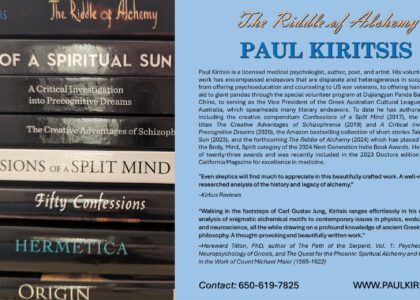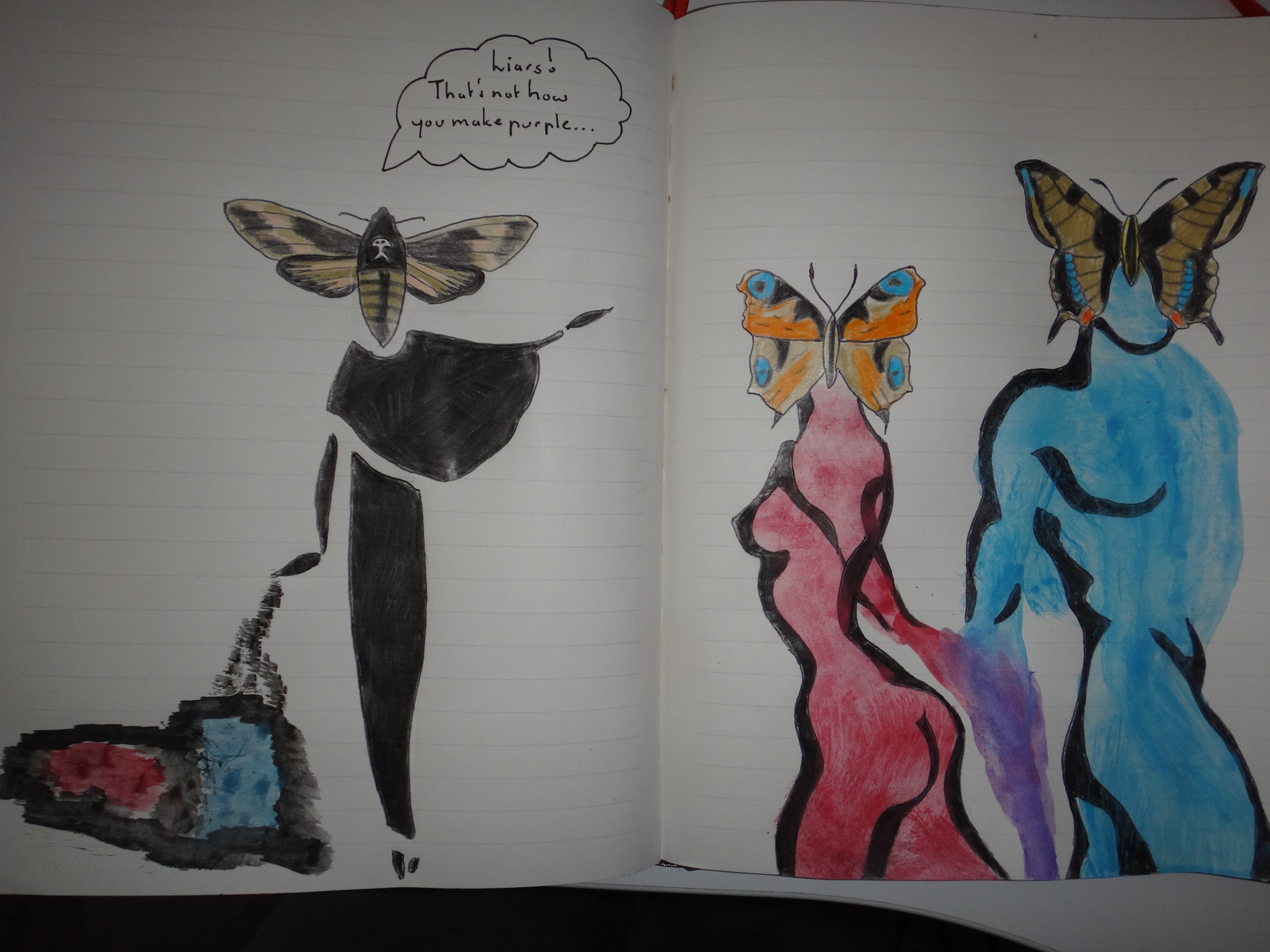
The seventh stage of the therapeutic process is a recapitulation of the first (the nigredo) where the matter in the alembic is gradually reduced to its primordial, undifferentiated state of prima materia by manner of incineration. Alchemists often imagined that the vapour condensing at the top of the vessel during this phase was the liberated ‘soul’ of the metal, chemical, or substance undergoing blackening and putrefaction. What this means in psychological terms is that the integrated constellation of unified Oneness achieved during the preceding lesser conjunctio has reached critical mass and has spontaneously activated its polar opposite. The switch back to multiplication and further differentiation brings to light more dross and some of the deeper shadows of the personality that the first nigredo wasn’t able to liquidate. If the analysand wishes to penetrate further and achieve individuation and that illusive state of illumination, any pre-existing and newly formed projections that appropriate transpersonal energies to fulfil the ego’s own personal needs, drives, gains, demands, and lower-level pleasures must be obliterated and wiped clean from the psyche’s innately wired software programs. Failure to consolidate here means a death sentence for the client-counsellor synergy and the therapeutic endeavour as a whole.
Left unaided, individuation works quite like a set of dominoes or a pebble being dropped in the midst of oceanic doldrums. One act sets in motion the entire process. Thus the inner hermetic fires which ‘cooked’ the ego and purged it of the aforementioned contaminations in the first nigredo are resurrected temporarily in the second to duplicate their corrosive action again. Here, at the deepest level of the psyche, the transition to mortificatio is articulated telepathically by the corroborating dreambody through nocturnal visions and images of overflowing toilets, couples or individuals being beheaded, eviscerations, mutilations, flagellations, and all other modes of torture, suffering, and death. As the darkest operation in alchemy, mortificatio can be quite an overwhelming and disheartening experience. But a force that can so readily depress the human soul is also liable to raise it to heights unfathomable and imperceptible to its sister operations. What the ego perceives as a personal defeat is really an undisclosed victory for the Self, for there can be no flowering of consciousness from the seedy womb without periodic surrenders to the negative experience of Christ-like passion and self-sacrifice. One cannot self-actualize without the pathos and threnos of suffering.
In transpersonal psychotherapy mortificatio can be equated with the realization that, just like everything else subject to the cosmic cycles of birth, death and regeneration, the counsellor-client synergy has an indefinite lifespan and will soon come to an end. In this way it mimics relationships built in the real world which eventually climax and run aground onto stagnant reefs once the interacting forces, the projected psychological makeup of two individuals, have exhausted one another’s potential compatibilities. When performed contentiously, correctly and with much panache, relationships with professional grounding can be just as meaningful as personal ones and involve the transference and countertransference of gut-level sentiments like love, consecration, and loyalty. Furthermore, their predilection to eliciting productivity, purposiveness, meaningfulness, lucidity, and freshness in life by exalting order and raising their subject to ecstatic heights from whence he or she might behold a spiritual alpenglow is something that even the mightiest in resolve would struggle hard to abandon.
A chief aim of counselling is to propagate the opinion that a degree of self-love isn’t aberrant or undesirable; in fact, it’s a necessary precursor to the development of a confidence that enables one to act into the environment without the harassment and stress that comes from being the owner of an overbearing conscience or nagging self-doubts. Another of its aims is to encourage self-reliance and poise. As a general rule effective therapy can be a very a liberating and empowering experience, originating attitudes to life worthy of eternal embracement. We can also define it as an artificial or artificial set of circumstances that work with the inner realm (not exclusively though) to make psychospiritual gold from the lead of neuroses, unusual addictions and fixations, and negative mental states. From this perspective it’s not difficult to understand why termination of the process is perceived as a loss by the analysand and kicks up about as much emotional dust as what the ending of a natural relationship does.
All things considered, mortificatio means that all the constituent parameters that made therapy a habitual and stable part of the client’s life–time, place of appointment, and level of intensity–are now dissolving and the processes of healing, reintegration, and the resolution of conflicts will either go on unaided in the natural world or enter into communion with a different counsellor. A good counsellor knows when this symbolic death is imminent and will do everything in his or her power to ensure that positive changes achieved during hermetically sealed operations in the counselling room are smoothly and subtlety transliterated into a dialect comprehensible to the rhythms and cycles of real life. The better this is done, the less likelihood there is of the analysand suffering another self-sabotaging setback, regression, or crisis in self-esteem. Of course the weight of making these transitions concrete in the real world is the sole responsibility of the analysand. The counsellor opens up all viable ways to healing through therapy yet all pivotal decision-making is faithfully left to the intuitive devices of the analysand. In the end, whatever course of action he or she chooses to take is going to involve making a choice or a series of choices. As we so clearly witnessed from our phenomenological exploration of madness and hallucinations, building a proactive future is all about making premeditated choices and subsequently taking actions compatible with one’s natural inclinations and inner life.
There can be no doubt that those individuals who remain motionless or hesitant for too long without going this or that way end up suffering dire consequences. But linear progression along the multifaceted therapeutic cycle from the death and defeat associated with nigredo to the comprehensive and contemplative vision of albedo is no reassurance of salvation either. Just as white contains the latent seeds of darkness and creation those of destruction, so too does a new perspective or evolutionary standpoint in life contain within it the very real potential for a second devolution and dismemberment at the hands of the psyche’s own inner doubting Thomas. New ways of thinking can slip back into rusty old psychic frameworks, personal relationships might be reassessed under the mediation of a far more critical and judgemental eye, and the problem of transference and countertransference can rear its head in more prominent ways than before.
This second baptism into the deleterious fires of torture, death, and decomposition is always bound to stir up overwhelming, fiery emotions like frustration and anger. The analysand might voice these sentiments through negative declarations like: “Why has this issue come up again?”, “Why the same feelings again as before?”, or “I feel like we’re just going around and around in circles.” It’s important for the facilitating therapist to address and dissolve thought-desires of this colour and intensity in the counselling sessions preceding termination otherwise the client can leave feeling that the psychological synergy with the counsellor hasn’t been terminated; that business remains incomplete; and that he or she is free to walk back into therapy from the unstipulated pause at any time. Actually, the critical importance of hermetically sealing termination through the illumination of boundaries and conditions cannot be stressed enough!








